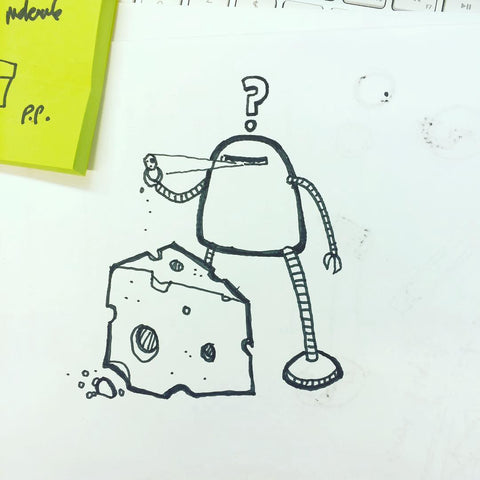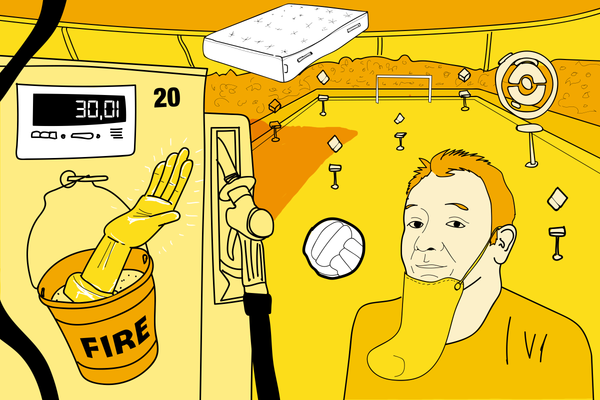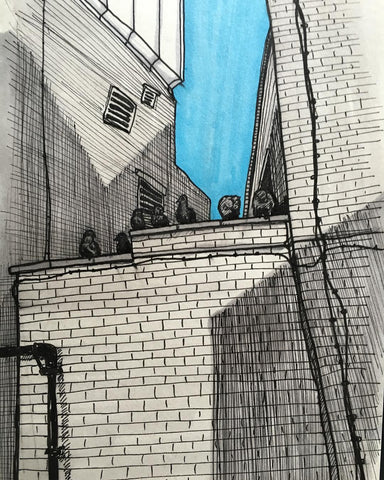Less design more detail
Once in a while I go through lazy phases but historically have always carried a sketchbook around with me and drawn. I draw a lot but it tends to be obscure doodles, cartoons, thoughts, stupid inventions, todos, notes or product design ideas.





A side project
I’ve actively been sketching at least once a day for the past few months.
By sketching I mean drawing outside of the usual realms of thoughts, commissions, work and design. Less about concepts, more about drawing things from life; objects, settings, sometimes people but mostly architecture.

Some call it urban sketching some call it drawing your surroundings and what you know. I just do it to stop myself from going mad sometimes.
Detail
Creatively, I tend to be really untidy, inaccurate, scrappy, abstract and sketchy. It’s more about problem solving than refinement.
My desk is a tip. When writing music I kind of come up with a general idea. It’s probably slightly different the next time I play it if I haven’t forgotten it by then. When painting I do a few crude blobs and that’s it. When sketching out UI I tend to scruffily produce a few sketches for a general idea only I can possibly understand until I involve others in the conversation or refine it a bit more in a browser and start focusing on the details in code. Being a generalist can sometimes feel very general.
Maybe sketches for me have always been just the starting point.
I wanted to focus on and develop the discipline and details; ratios, perspective, shadows, scale, tiny little windows.

Time
There’s nothing more irritating than when somebody says “How long did that take you?” or “How much spare time do you have?” Often we assign the value of something in terms of how long it took.
You don’t need much time at all to sketch.
In fact you can specifically use the little time you do have to maximise your skills.
Just a few minutes
Make full use of queues, bus trips, pointless meetings, waiting rooms and friends who are perpetually late. If I only have 5-10 minutes I set a timer on my phone and see what I can do in that short time and at what level of detail or accuracy, letting the time I have define the scope of the sketch.
Detail ≠ Accuracy.
Accuracy ≠ Detail.

You can either give the intricate details of a window all your attention for 5 minutes or try and accurately represent the overall scale, composition and atmosphere of a whole scene in the same amount of time.
One minute
Timed sketches of 60 seconds are quite a common approach to rapid sketching and interpreting complex subject matter with simple lines.

But remember the goal I set out with was to develop the details and levels of accuracy that I normally skim over or portray in my usual clumsy, crude way. Accuracy and detail require a degree of time, or at least more than a frantic minute of scribbling.
However, you might think you can’t achieve much in a minute but what if it were the same drawing but a different minute each day?

I have been experimenting with sketching a few scenes for exactly one minute each day on my commute to and from work. Giving that 60 seconds my full attention, adding to the drawing each day a minute at a time.

I’m still experimenting but I’m wondering if these types of drawings are the result of more than the usual amount of focus and concentration.
Try similar sketches for similar periods of time, look back at previous sketches and see how you either draw more, achieve more accuracy or detail over time.
Location
Write down the location of your sketch and which direction you were facing. Draw a tiny map if you need to. It’ll help if you ever go back and try sketching the same scene in the future.

The project so far…
Here are a few things I’ve posted on twitter and instagram. There’s a mixture of illustrations mostly from around London and Copenhagen.

















Tools
I’m often asked what tools I use and while ultimately it doesn’t matter what you use or how much it costs there are a few things to consider when you’re trying to hone your skills or preserve the life of your work.
Pencils
I don’t have a great deal of advice for pencils, I mostly use pens. On the cover picture for this article I drew that scene from Clerkenwell from a quick field sketch in pencil and finished in pen when I got home. I use Blackwing 602 pencils most of the time when I am not carrying much. They come with a rubber too.
Pigma Micron
Pigma Micron pens are great. I generally use 01, 05 and 08 but they come in many sizes. When it comes to maintaining the life of your work, they use archival ink.

They’re readily available, pretty cheap, reliable and last quite a while. Kind of a work horsey pen. These pens really affect my drawing style, I tend to be very focused, deliberate, straight-lined and neat when I use these.
Lamy fountain pens
I find I’m drawing more and more observational sketches using a fountain pen.
I’ve a couple of more expensive fountain pens but you can’t beat Lamy pens for being affordable and comparable with the more expensive pens. A £300 Japanese fountain pen might well be great but if it’s something you intend to carry around with you every day you’re going to eventually drop it on its nib or lose it.
Reserve something like that for your studio not your back pocket.
Fountain pens allow you to draw accurately but give you freedom should you need to express movement, scratchiness or personality. You can create varied stroke widths, pressures or angles without changing pens.
While I prefer a fountain pen and am using them more and more there’s always the risk it’ll leak so I tend to be less inclined to carry one on my commute.
Ink
You can’t really use archival ink in your day-to-day fountain pen without continually flushing it out to stop it clogging up. I prefer a really dark ink and it needs to be waterproof if you wash over the drawing with some watercolour or stop you smudging it (or if it’s your daily sketchpad it will get wet one day).
Winsor and Newton Indian ink that’s very slightly watered down works really well. It’s very dark and waterproof.
Note: No matter how careful you are you will knock over a whole bottle of ink at least once in your lifetime. Be prepared for this day.
Sketch pads
Designers often fetishise their tools and it’s common for designers to get out their Moleskine pad and square it up neatly next to their open MacBook with their favourite unused pen in a coffee shop. While I have mostly used Moleskines to-date with more and more sketches being done with a fountain pen I’m turning towards Leuchtturm1917 sketchbooks which have hardly any bleed.
For more polished pieces of artwork it’s always best to stick to only using one side of your pad regardless of how it performs in terms of bleed. Even the best paper will show what’s on the other side if you scan it in.
But when you’re doing countless studies, experiments and practice sessions you want to make the most of the paper you have so use both sides.
The cost of these sketchbooks can mount up over the course of a year. The kind of thing you draw and where you’ll be drawing it will help you decide on what binding, page size, texture, orientation, cover or paper type you need. There’s quite a wide range of pads available outside of the more expensive Moleskines or Leuchtturm1917 range for all budgets. However whilst some pads are a 10th of the cost of the more expensive brands, you might not currently think the life of your experiments, sketches or studies are that important but you may want to turn back to them one day in the future so try to use a good quality acid-free paper and use archival ink even for seemingly throwaway work.
